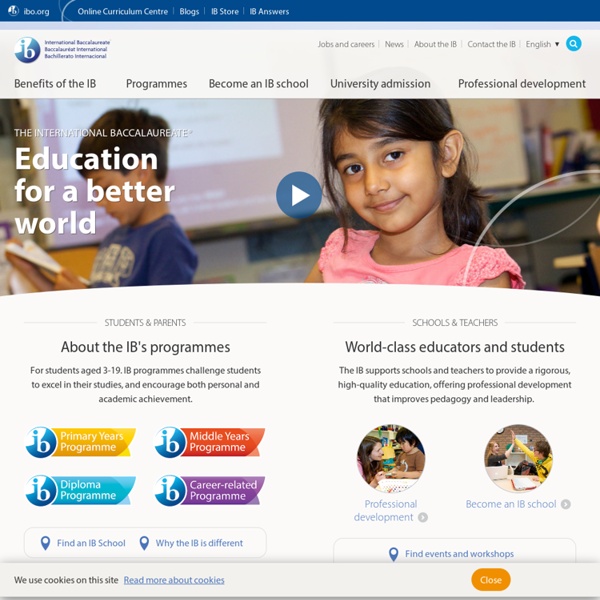



Helping Students Cope With Uncertainty: Advice From a Psychologist - Ask a Psychologist: Helping Students Thrive Now There is so much debate right now about what will happen with schools, the economy, and so much else. I'm having trouble coping with uncertainty and don't know what to say to my students. What do you advise? International Baccalaureate Logo of the International Baccalaureate. Marie-Thérèse Maurette[5] created the framework for what would eventually become the IB Diploma Programme in 1948 when she wrote Is There a Way of Teaching for Peace?, a handbook for United Nationsite.[6] In the mid-1960s, a group of teachers from the International School of Geneva (Ecolint) created the International Schools Examinations Syndicate (ISES), which would later become the International Baccalaureate Organization (IBO).[7] by Peter Nehr, International Baccalaureate Africa, Europe and Middle-East (IBAEM) was established in 1986,[8] and International Baccalaureate Asia Pacific (IBAP) established during the same period.[9] The IB Middle Years Programme (MYP) adheres to the study of eight subject areas and was developed and piloted in the mid-1990s. Diploma Programme curriculum outline[edit]
Top 100 Sites of 2011 1/12/2012 By: The time is finally here for my annual list of favorite sites of the year. This year I decided to up my post to the top 100 instead of 25 because of the number of sites that I reviewed and the popularity of the post. I tried to cover a wide range of sites, from flash-card creators to digital storytelling, and of course social networks, which really stood out in 2011. I hope everybody enjoys the list and has as much fun reading it as I did creating it. Greek vs Hebrew Education What we now consider “The Church” is almost nothing like the Early New Testament Church. Think of an archeologist digging through layers to find out what life was like in ancient times. Historians concur that the Greeks were destroyed by moral decay. Pursuing knowledge without God is a recipe for disaster. We simply cannot survive without clear moral direction. Look at the differences in education goals:
Keep It Simple Standards-Based Grading Keep It Simple Standards-Based Grading (K.I.S.SBG.) This post will probably raise the ire of SBG purists. If you are considering switching to SBG, I say go for it. Even if it means you keep it simple the first year, as you and your students figure it all out for the first time. Water Tank Engineering with Newspaper, Part 1 - Vista Think MYP Design Cycle – Getting Started In July of 2015, I taught my first design unit in grade: water tank engineering from newspaper. Middle school design teachers and colleagues Jessie M. and Angie U. created the first version of the unit.
Resources & Tools Grants NEA Foundation Grants The NEA Foundation's Innovation Grants provide an opportunity for teachers, education support professionals, and higher education faculty to develop and implement innovations that significantly improve student learning. Eligible applicants may submit a proposal at any time. Teaching the iGeneration: It's About Verbs, Not Tools UserID: iCustID: IsLogged: false Classes - Instructables AdWords We use AdWords to deploy digital advertising on sites supported by AdWords. Ads are based on both AdWords data and behavioral data that we collect while you’re on our sites. The data we collect may include pages you’ve visited, trials you’ve initiated, videos you’ve played, purchases you’ve made, and your IP address or device ID. This information may be combined with data that AdWords has collected from you. We use the data that we provide to AdWords to better customize your digital advertising experience and present you with more relevant ads.
Kumon method Kumon History[edit] In 1954, Toru Kumon began to teach his eldest son, who was having problems in mathematics at school. Kumon developed the Kumon Method. In 1978, Kumon opened the first Kumon Center in Osaka, Japan with the help of parents who were interested in the Method. In 1990, he founded the Kumon Institute of Education, after which Kumon Centers began to open around the world. A Tale Of Three Teachers The young teacher started right off making a rookie mistake in the opening minutes of his first class, on his very first day. “How many of you know what a liter is?” he asked his high school math class. “Give me a thumbs up if you know, thumbs down if you don’t.” None of the kids responded, so he entreated, “Come on, I just need to know where you are.
10 Great Free Web Tools for Teachers and Educators Educational Technology and Mobile Learning has handpicked for you some great educational web tools that we have come across in different websites and blogs during the last week. We are adding the list to the section called Educational Web Tools where we provide busy teachers and educators with resources and links about educational web technologies . Check out the list below and let us know what you think. MYP Resources You can take a one month free trial for any InThinking site if you have neither had a paid subscription nor a free trial in the last two years. Our teacher sites include INTEGRATED STUDENT ACCESS which enables you to set tasks and give feedback online. Student access is easy to set up; you can set reading, writing, discussion, and multiple choice tasks; and you can track student progress. To sign up, go to: You might also encourage your students to sign up for our DP revision websites, most of which are FREE.
Get support, and questions answered here! by jeanem Feb 10